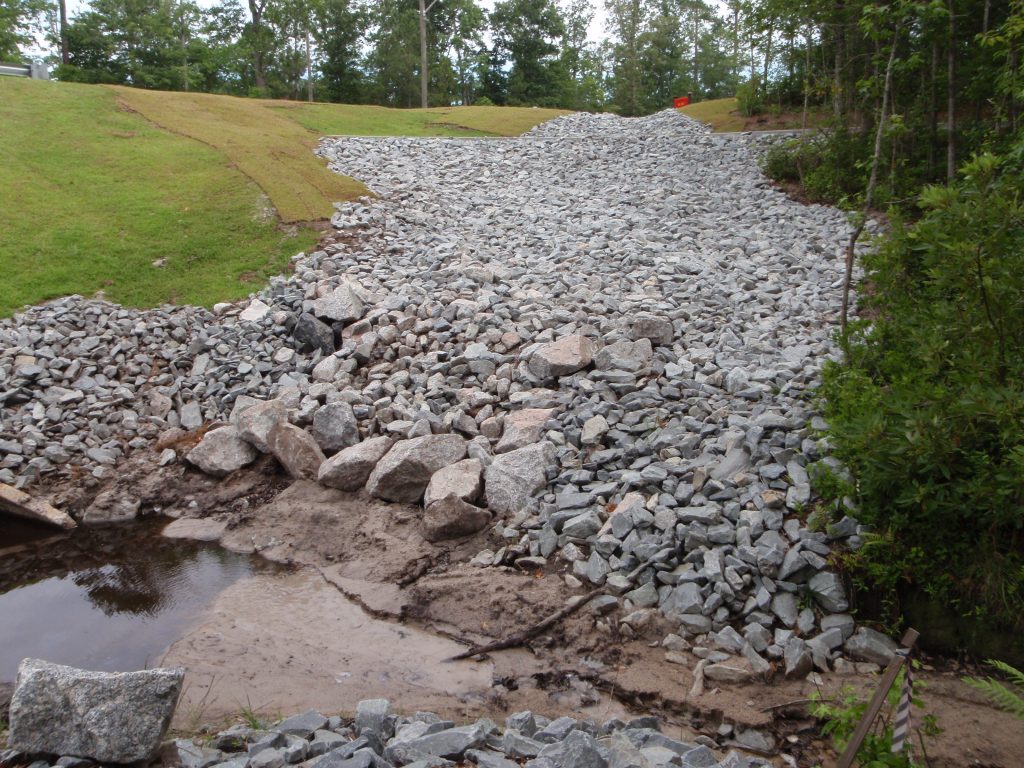Part of our goal is to help our clients comply with the complex regulations concerning development. The Clean Water Act National Pollutant Discharge Elimination System (NPDES) requires stormwater and erosion control practices to address local water pollution and compliance concerns. During land disturbing activities above various thresholds, depending on the activity and location of the project, regular NPDES monitoring must be completed to ensure compliance with permit conditions and evaluate the effectiveness of stormwater and erosion control structures. Our team is certified with the NCDOT Erosion and Sedimentation Control/Stormwater Certification Program at Levels I, II, and III. To keep you in compliance with permit requirements, we can:
- Level I: Inspect the installation of erosion and sediment control on project construction sites.
- Level II: Inspect grading work, culvert replacement, and bridge construction
- Level III: Develop and design erosion and sediment control plans, including reclamation plans
The National Pollutant Discharge Elimination System (NPDES) is a permitting program authorized by the Clean Water Act to regulate point sources that discharge pollutants into waters of the United States. NPDES reporting involves the submission of various reports and data to regulatory agencies to demonstrate compliance with permit requirements and water quality standards. Here’s an overview of NPDES reporting:
1. Permit Application and Annual Reporting:
- Facilities subject to NPDES permitting must submit permit applications detailing their operations, discharge points, pollutant limits, monitoring requirements, and other relevant information.
- Permittees are typically required to submit annual reports summarizing their activities, pollutant discharges, monitoring results, and compliance status during the reporting period.
2. Discharge Monitoring Reports (DMRs):
- Permittees must regularly monitor their discharges and submit Discharge Monitoring Reports (DMRs) to regulatory agencies.
- DMRs provide detailed information on the volume and characteristics of pollutants discharged, sampling methods, analytical results, and compliance with permit limits.
3. Toxicity Testing and Reporting:
- Some NPDES permits require toxicity testing to assess the potential impacts of discharges on aquatic life.
- Permittees may be required to conduct toxicity tests on effluent samples and report the results to regulatory agencies to ensure compliance with toxicity-based permit limits.
4. Compliance Monitoring and Reporting:
- Regulatory agencies conduct compliance inspections and monitoring to verify permit compliance and assess environmental impacts.
- Permittees are responsible for maintaining records of monitoring data, inspection reports, corrective actions, and other compliance-related documentation, which may be subject to regulatory review and reporting requirements.
5. Annual Compliance Certification:
- Permittees are typically required to submit annual compliance certifications affirming that they have complied with all permit conditions, monitoring requirements, and regulatory standards during the reporting period.
- Compliance certifications may include signed statements, documentation of monitoring results, and any necessary corrective actions taken to address non-compliance.
6. Electronic Reporting:
- Many regulatory agencies have transitioned to electronic reporting systems, such as the EPA’s Integrated Compliance Information System (ICIS-NPDES), to facilitate the submission of NPDES reports and data.
- Electronic reporting streamlines the reporting process, improves data accuracy, and enhances regulatory oversight and enforcement capabilities.
7. Recordkeeping and Retention:
- Permittees are required to maintain accurate records of their NPDES activities, including permit documents, monitoring data, inspection reports, and correspondence with regulatory agencies.
- Records must be retained for a specified period, typically three to five years, to demonstrate compliance with permit requirements and regulatory obligations.
NPDES reporting plays a crucial role in ensuring the protection of water quality and environmental resources by providing regulators with essential information to evaluate permit compliance, identify potential issues, and enforce regulatory requirements. Compliance with NPDES reporting requirements helps minimize pollutant discharges and mitigate adverse impacts on aquatic ecosystems and public health.

